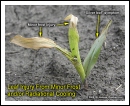

![]() pril
began very warm but ended dismally cold and dreary. Because of the exceptionally
warm beginning to April, growing degree day (GDD) accumulations for the month
were actually greater than average (Indiana
Ag. Statistics, 5/2/05). Corn planted near mid-month, however, has experienced
primarily cooler than normal temperatures and many cloudy days to date.
pril
began very warm but ended dismally cold and dreary. Because of the exceptionally
warm beginning to April, growing degree day (GDD) accumulations for the month
were actually greater than average (Indiana
Ag. Statistics, 5/2/05). Corn planted near mid-month, however, has experienced
primarily cooler than normal temperatures and many cloudy days to date.
 April 2005 air temperatures in westcentral Indiana. April 2005 air temperatures in westcentral Indiana. |
 April 2005 growing degree day (GDD) accumulation
in westcentral Indiana. April 2005 growing degree day (GDD) accumulation
in westcentral Indiana. |
At the Purdue Crop Diagnostic Training & Research Center near W. Lafayette, corn planted on Apr 5 reached 50% emergence 13 days later on Apr 18, fairly quick for such early planting. Corn planted Apr 10 reached 50% emergence only 10 days later on Apr 20, reflecting the even warmer temperatures during that time period. Corn planted Apr 20, the day before the cold snap began, had germinated but not yet begun to emerge 13 days later (May 3).
 Pre-emergence corn seedlings 13 days after Apr 20
planting. Pre-emergence corn seedlings 13 days after Apr 20
planting. |
 Pre-emergence corn seedling 13 days after Apr 20
planting. Pre-emergence corn seedling 13 days after Apr 20
planting. |
 Pre-emergence corn seedling 13 days after Apr 20
planting. Pre-emergence corn seedling 13 days after Apr 20
planting. |
Recognize that these calendar times to emergence are in tune with what we would expect based on thermal time (accumulation of GDDs). The first two planting dates reached 50% emergence roughly 121 to 128 GDDs (using soil temperatures) after planting. As of May 3, cumulative GDDs for the Apr 20th planting were only about 60 or about half of what is required for emergence to occur.
Growers who planted corn during the first half of April are naturally concerned
about the health of emerged stands (given the multiple occurrences of frosts
 and near-lethal temperatures coupled with sub-optimal
temperatures and lack of sunshine) and wonder whether fields not yet emerged
will ever do so. Some feel the emotional pressure to replant to put an end to
their misery (the grower’s, not the corn plants’). After all, those putrid yellow-brown-green
plants surely can never recover to achieve their original yield potential, right?
and near-lethal temperatures coupled with sub-optimal
temperatures and lack of sunshine) and wonder whether fields not yet emerged
will ever do so. Some feel the emotional pressure to replant to put an end to
their misery (the grower’s, not the corn plants’). After all, those putrid yellow-brown-green
plants surely can never recover to achieve their original yield potential, right?
It is true that the combination of cold temperatures, light frost, often-cloudy weather, and (for some) saturated soils is not particularly favorable for rapid and uniform corn emergence or stand establishment. The cool, cloudy weather has also delayed overall crop development to the extent that it is very difficult to determine whether a stressed field will recover satisfactorily or will continue to deteriorate with eventual significant stand losses.
The warmer temperatures forecast for the latter part of this week will not only hasten the pace of crop development, but will also better enable growers to assess the condition of their early-planted fields. As I indicated in my most recent article (Nielsen, 2005), growers should not rush to replant these suspect fields. Here are some points to consider.
 For
some fields, the final “shoe” that may yet “drop” could be the eventual development
of seed or seedling disease in these otherwise struggling early-planted corn
fields once the effectiveness of seed-applied fungicide deteriorates 2 to
3 weeks after planting (Malvick,
2005).Continue to monitor fields over the next few weeks for such disease
development.
For
some fields, the final “shoe” that may yet “drop” could be the eventual development
of seed or seedling disease in these otherwise struggling early-planted corn
fields once the effectiveness of seed-applied fungicide deteriorates 2 to
3 weeks after planting (Malvick,
2005).Continue to monitor fields over the next few weeks for such disease
development. Indiana Ag. Statistics. 2 May 2005. Indiana Crop & Weather Report. Vol. 55, No. 18. U.S. Department of Agriculture. Available online at http://www.nass.usda.gov/in/cropweat/2005/we1805.pdf [URL verified 5/3/05].
Loux, Mark. 2005. Replanting Roundup Ready Corn – how to kill the first planting? Crop Observation & Recommendation Network, Ohio State Univ. Available online at http://corn.osu.edu/index.php?setissueID=81#J [URL verified 5/3/05].
Malvick, Dean. 2005. Corn Seed and Seedling Diseases. Illinois Pest & Crop Bulletin. Univ. of Illinois. Available online at http://www.ipm.uiuc.edu/bulletin/article.php?issueNumber=6&issueYear=2005&articleNumber=3 [URL verified 4/29/05].
Nielsen, R.L. (Bob). 2003. Estimating Yield and Dollar Returns from Corn Replanting. Purdue Univ. Cooperative Ext. Service Publication AY-264-W. Available online at http://www.agry.purdue.edu/ext/pubs/AY-264-W.pdf [URL verified 4/28/05].
Nielsen, R.L. (Bob). 2005. Stress Continues for Corn Growing Under Refrigerated Conditions. Corny News Network, Purdue Univ. Available online at http://www.kingcorn.org/news/articles.05/RefrigCorn-0429.html [URL verified 5/3/05].
Thomison, Peter. 2005. Corn Replanting Considerations - don’t be in rush to replant. Crop Observation & Recommendation Network, Ohio State Univ. Available online at http://corn.osu.edu/index.php?setissueID=81#I [URL verified 5/3/05].